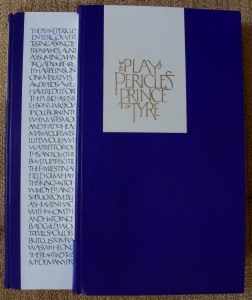 At long last, after an incredible journey mimicking Pericles own peregrinations, I have the pleasure of owning, reading, caressing, and admiring the Barbarian Press Pericles. From first sight, I knew this book would be one of my favorite fine press books, and the month or so that it has been in my hands has just solidified that first impression. Before it ever made it into my hands, it had already won the First Prize for Limited Editions at the 2011 Alcuin Society Awards for Excellence in Book Design in Canada and got major kudos at CODEX 2011 in Berkeley in February. It is breathtaking in so many ways that I doubt I can do it justice here. But I’m going to try.
At long last, after an incredible journey mimicking Pericles own peregrinations, I have the pleasure of owning, reading, caressing, and admiring the Barbarian Press Pericles. From first sight, I knew this book would be one of my favorite fine press books, and the month or so that it has been in my hands has just solidified that first impression. Before it ever made it into my hands, it had already won the First Prize for Limited Editions at the 2011 Alcuin Society Awards for Excellence in Book Design in Canada and got major kudos at CODEX 2011 in Berkeley in February. It is breathtaking in so many ways that I doubt I can do it justice here. But I’m going to try.
This book has been over ten years in the making at the Barbarian Press and took at least a couple of years longer to land on my doorstep than I was thinking when it was first announced. As Crispin announced in a status letter back in March:
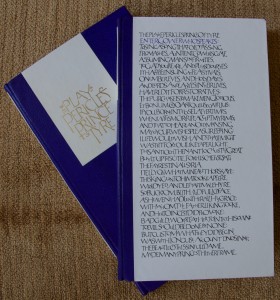 “Pericles’ adventures, as you will all find out before long, are many and varied, and by no means are all of them pleasant or fair – although I will spoil the story to the extent of assuring the more timorous among you that all does end well. Along the way, however, the Fates decree more than their share of trouble for him.
“Pericles’ adventures, as you will all find out before long, are many and varied, and by no means are all of them pleasant or fair – although I will spoil the story to the extent of assuring the more timorous among you that all does end well. Along the way, however, the Fates decree more than their share of trouble for him.
If it is true that Life imitates Art, then the making of this edition of Pericles proves the rule in this one respect. Whether we call it Fate, Destiny, Life, or simply Sod’s Law, our edition has run into rather more than its share of delays and storms along the way. “
As far as I can tell, the Elsted’s kept a positive and cheerful attitude during the books journey, as it seems one must to keep one’s sanity in the fine press business.
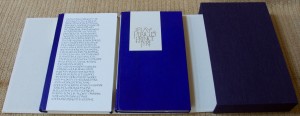 The book was published in two states: a deluxe edition that I hope to see one day and my marvelous “standard” edition. It consists of two volumes encased in a chemise and slipcase: the play itself is bound in full purple morocco leather with gold stamped vellum labels on the cover and spine and a commentary volume bound in quarter morocco leather with printed paper sides and vellum spine label designed by Andrea Taylor. The
The book was published in two states: a deluxe edition that I hope to see one day and my marvelous “standard” edition. It consists of two volumes encased in a chemise and slipcase: the play itself is bound in full purple morocco leather with gold stamped vellum labels on the cover and spine and a commentary volume bound in quarter morocco leather with printed paper sides and vellum spine label designed by Andrea Taylor. The  talented Alanna Simensen did the binding work. The illustrations are by the amazing Simon Brett, the book was designed and type-set by Crispin Elsted, and Jan Elsted printed the text and illustrations. The paper is Zerkall and the types are Poliphilus & Blado with Duensing for display. One of the striking features of this edition is the use of several colors for the type. The colors are used to correspond to the different locations of the action throughout the play. I really love the way the various sizes and colors of the type flow across the pages.
talented Alanna Simensen did the binding work. The illustrations are by the amazing Simon Brett, the book was designed and type-set by Crispin Elsted, and Jan Elsted printed the text and illustrations. The paper is Zerkall and the types are Poliphilus & Blado with Duensing for display. One of the striking features of this edition is the use of several colors for the type. The colors are used to correspond to the different locations of the action throughout the play. I really love the way the various sizes and colors of the type flow across the pages.
The press’ stated intention was to “publish a text which would be a pleasure to read, and would allow the glories of this unfairly neglected play to find new devotees.” Simon wanted to “stage” the play on the page, and “bring to life the silences, illustrate the dumbshows, articulate the voyages.” They have definitely achieved their objective.
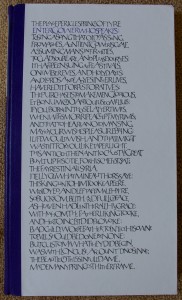 The commentary volume contains essays and information on the play. Simon Brett contributes one essay on how the illustrations and the book were made. Crispin has one on reading the play and then another addressing the authorship question of Pericles. This is followed by a suggested bibliography and then notes on the text. These essays make for interesting reading and the reverence that Brett and the Crispin’s hold for Shakespeare come through strongly.
The commentary volume contains essays and information on the play. Simon Brett contributes one essay on how the illustrations and the book were made. Crispin has one on reading the play and then another addressing the authorship question of Pericles. This is followed by a suggested bibliography and then notes on the text. These essays make for interesting reading and the reverence that Brett and the Crispin’s hold for Shakespeare come through strongly.
In On the Making of Pericles, Brett asserts that
“Our Pericles is a traditional book; it is not experimental; it does not question the form of the book itself: it is there ‘to sing a Song that old was sung’. It is, for the moment, our attempt at an answer to the question of the illustrated book.”
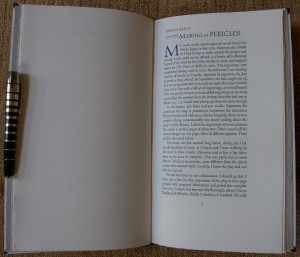 He also talks about the way he went about illustrating the spectacles and action within the play and how that differs from process he might use for a novel or other form of literature.
He also talks about the way he went about illustrating the spectacles and action within the play and how that differs from process he might use for a novel or other form of literature.
“When something happens on the stage which moves beyond the words, we show it; we bring to life what on the page are silences but what in the theatre is noise, music, and action. These moments require and immediacy of presence in contrast to the conventional distancing of the more formalized passages, and hence a more immediate style of engraving.”
As to what kept him going through the long process of the books development while dealing with both life challenges and the fine press process, he asserts that “…Crispin and I have made this book out of our love for our daughters.”
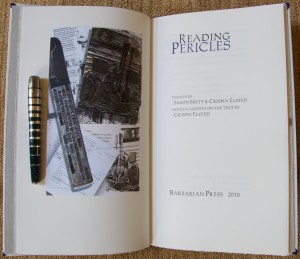 The next essay is Reading Pericles by Crispin Elsted. In it, he starts off stating their intention in publishing the play. This is not intended to compete with the scholarly or critical editions of the play nor is it for the stage. As Crispin says:
The next essay is Reading Pericles by Crispin Elsted. In it, he starts off stating their intention in publishing the play. This is not intended to compete with the scholarly or critical editions of the play nor is it for the stage. As Crispin says:
“…if an edition of any play for reading (rather than for performance) is to be anything more than a ‘score’, it must at least attempt to suggest performance—to imply movement, vocal nuance, & elements of a mise en scene in the imagination.”
He goes on to describe his process in coming up with a text for the edition. Pericles survived Shakespeare’s time only in a single text from the 1609 quarto and it is acknowledged to be corrupt and, in Crispin’s words, an “unholy mess”. He drew his text from the original and succeeding quartos and the various reference materials available and he talks in detail about the issues he faced. Setting the text also provided valuable insight into the play and its genesis, sometimes suggesting modifications to the text that were not apparent otherwise. As Crispin writes:
“But if hand-setting books for more than thirty years has shown me anything, it is that few processes bring one closer to a piece of writing than setting it letter by letter, word by word, sentence by sentence, line by line.”
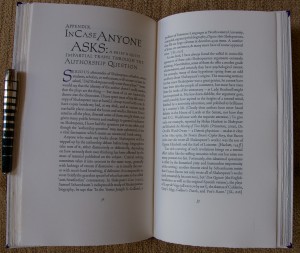 He spends the rest of the time in the essay discussing the question of collaboration and authorship of Shakespeare’s plays in general and of Pericles specifically. This section introduces the shadowy figure of George Wilkins, author of the novel The Painfull Adventures of Pericles Price of Tyre, Being The true History of the Play of Pericles, as it was lately presented by the worthy and ancient poet John Gower. This essay is supported by further discussion in the Appendix dealing with the authorship question in more depth.
He spends the rest of the time in the essay discussing the question of collaboration and authorship of Shakespeare’s plays in general and of Pericles specifically. This section introduces the shadowy figure of George Wilkins, author of the novel The Painfull Adventures of Pericles Price of Tyre, Being The true History of the Play of Pericles, as it was lately presented by the worthy and ancient poet John Gower. This essay is supported by further discussion in the Appendix dealing with the authorship question in more depth.
All in all, the commentary volume is a fascinating read for anyone interested in this less well know play or in Shakespeare in general.
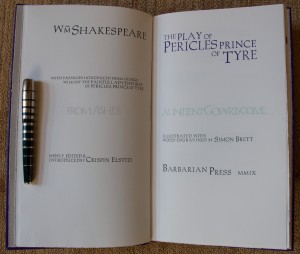 The Pericles volume is very elegant in it’s full purple morocco leather binding and clever use of type and color. I really love how Gower’s opening lines start on the front edge papers, continue through the title page and list of characters to the first page of the play. His closing lines then also play out into the back end papers.
The Pericles volume is very elegant in it’s full purple morocco leather binding and clever use of type and color. I really love how Gower’s opening lines start on the front edge papers, continue through the title page and list of characters to the first page of the play. His closing lines then also play out into the back end papers.
I enjoyed the play itself maybe more than expected given that this was not one of the well-known plays that come up when people 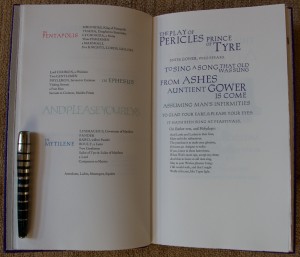 talk Shakespeare. I’m not sure I read it back when I devoured most of the Complete Shakespeare I bought with baby-sitting money back in junior high school. Part of that was in the presentation, I’m sure, as I believe the Barbarian Press hit their mark in making this reader’s edition. As I’ve stated in other posts, most recently with regards to the Limited Editions Club Toilers of the Sea, I really like when illustrations are worked into the text and flow across the page with obvious careful thought and purpose.
talk Shakespeare. I’m not sure I read it back when I devoured most of the Complete Shakespeare I bought with baby-sitting money back in junior high school. Part of that was in the presentation, I’m sure, as I believe the Barbarian Press hit their mark in making this reader’s edition. As I’ve stated in other posts, most recently with regards to the Limited Editions Club Toilers of the Sea, I really like when illustrations are worked into the text and flow across the page with obvious careful thought and purpose.
As in most of Shakespeare’s plays, I found several lines that I had to jot down as favorites:
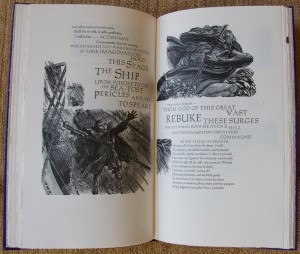 You Gods that made me man, and sway in love,
You Gods that made me man, and sway in love,
That have enflamde desire in my breast,
To taste the fruite of yon celestiall tree,
(or die in th’adventure) be my helpes,
As I am sonne and servant to your will,
To compasse such a bondlesse happinesse.
— Pericles; in Antioch I.1
‘Tis time to feare when tyrants seeme to kisse.
— Pericles; Tyre 1.2
Opinion’s but a foole, that makes us scan
The outward habit for the inward man.
— King Simonides; The City of Pentapolis II.2
And I don’t think I could summarize any better than Crispin did in Reading Pericles:
“To me, Shakespeare’s greatest work is in his comedies and romances. These are so 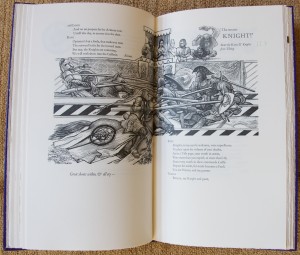 often played as varying species of farce, especially in Canada and the United States, that the deep humanity of their laughter, the pulse of their thought, and the extraordinary music of their language are lost in the sniggers & guffaws. Until we restore Comedy to a place coequal with Tragedy, & abandon the fashionable notion that grimness equals gravity, and self-absorption, breadth of vision, these plays will remain veiled. It is blindness compounded of self-indulgence and willful ignorance, the sadder for requiring no more than mindful attention for remedy.
often played as varying species of farce, especially in Canada and the United States, that the deep humanity of their laughter, the pulse of their thought, and the extraordinary music of their language are lost in the sniggers & guffaws. Until we restore Comedy to a place coequal with Tragedy, & abandon the fashionable notion that grimness equals gravity, and self-absorption, breadth of vision, these plays will remain veiled. It is blindness compounded of self-indulgence and willful ignorance, the sadder for requiring no more than mindful attention for remedy.
I believe that in the four romances at the end of his life Shakespeare touched a greatness which no other writer has come near. Although each play is flawed in its way—The Winter’s Tale is probably the most finished of the four, but I think Pericles is the best theatrically—they represent a stretching toward the ineffable unique in my cultural experience.”
Availability: There were 12 deluxe copies, with 4 hors commerce, and 125 standard copies printed. I believe the last orders were taken at CODEX 2011 in February well before the books shipped this summer.

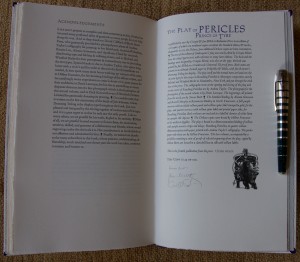

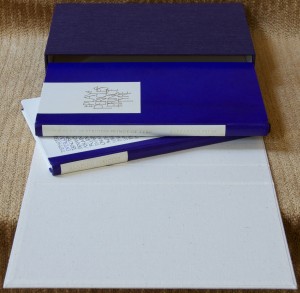
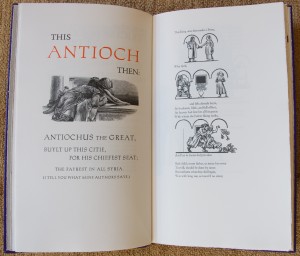
Pingback: The Play of Pericles Prince of Tyre, by William Shakespeare, Barbarian Press Edition « Books and Vines
Between you and ‘Busywine’, we are spoiled!
This is a magnificent book(s). The design and production standards hail back to the golden era of private presses. It is a breathtaking achievement for a press of Barbarian’s size to produce such a set of volumes.
The layout looks wonderful, the wood engravings are magnificent and I know the production values will be to the highest standards.
This is one of those books we will be reading about for years to come.
I really appreciate being able to view your images of this book and really enjoyed reading your review – thank you!
Best regards,
Neil
Wish I could find a copy! I did find some pictures of the deluxe edition, and
have to say this is one of the few times when I prefer the standard. Deluxe
is still beautiful though.